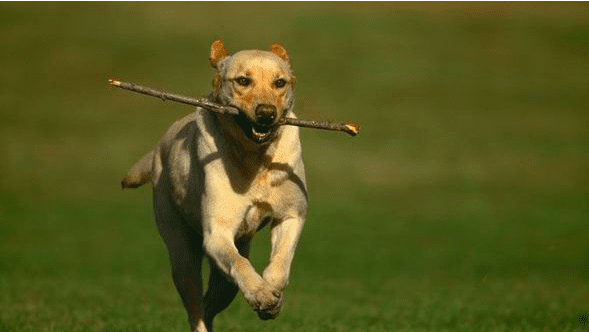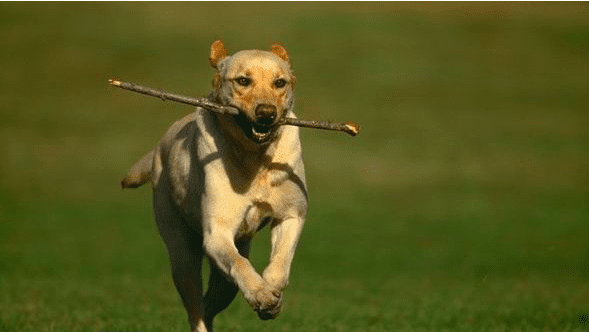

Humans need regular exercise to maintain optimal health. By moving our bodies, we strengthen bones and joints, manage weight and chronic conditions such as diabetes and heart disease, and improve the immune system and cognitive function. Regular exercise can also release hormones that decrease stress.
Our dogs are no different. And just like humans, they come in a variety of shapes and sizes. Because of age, breed and environmental variations, exercise requirements differ from dog to dog. We will specifically deal with the Labrador in this article.
How Much Exercise Does My Dog Need Each Day?
A good baseline for most canines is one hour of activity per day. Puppies will tend to play a bit more—but also SLEEP more too!
Breeds such as Border Collies are built to sustain high-intensity and a longer duration of activity. These breeds can be active for two or more hours per day, which may include chasing a frisbee, going for a run with their human, practicing flyball and similar activities.
Sighthounds like Whippets and Greyhounds need relatively little exercise to meet their physical and mental needs. Built for speed, they are content with three walks a day, and they thrive when provided a few, safe off-leash opportunities to reach their maximum velocity. They tire easily and aren’t endurance athletes. Many retired sighthounds become excellent apartment-dwelling companions.
Labradors need a minimum of ½ hour- 1 hour of exercise each day to stay toned and to keep their heart-healthy! Get it pumping!!! Swimming–you can go a bit longer–but I recommend a life-preserver to prevent exhaustion.
How Much Exercise Does a Puppy Need?
Because of their developing limbs, puppies from two to four months should be exercised multiple times a day for one to two hours cumulatively. At a very young age, a leashed walk is not needed and is unlikely to be very productive since puppies are so distractable. Although, practicing leash-walking skills and recall exercises, such as “come when called by name”, constitute physical activity.
Playing with a ball, hide and seek with a toy or treat or playtime with other healthy dogs can be productive. Hiking is also a safe activity you and your pup can enjoy together (and is not as hard on joints doing repetitive motion). New sights, smells, and terrain provides lots of opportunities for stimulation. Various muscle groups are utilized which is optimal for injury prevention and building strength–just like for us humans.
Of course, swimming is a low-impact, wonderfully fun activity in the place of walking!
How Much Exercise Does My Senior Dog Need?
Older dogs need exercise to maintain muscle mass, control weight, and provide enrichment. A good rule of thumb to follow for senior dogs is that they need roughly 30 minutes of exercise per day. If unable, a walk around the house can do a lot for a senior dog having joint issues. Developing and keeping the muscles around the joint in shape and holding it in place will give them many more years of mobility and life!!!
Swimming is an ideal exercise for senior Labs. They aren’t as likely to overheat, and the non-weight-bearing exercise is easy on arthritic limbs. It’s important to monitor your pet in the water as exhaustion can occur rapidly; life vests can help maintain buoyancy while allowing your pet to reap the benefits of swimming.
How Do I Know If My Dog Isn’t Getting Enough Exercise?
Dogs that aren’t receiving enough exercise are relatively easy to identify. Usually there is a bump of fat at the base of the tail making the tail look as if it’s hanging low. There is no waist when viewed from the top. Many times the “brisket” is oversized and adds weight to the dog, putting stress on joints—so keep them fit and light!!! If it’s a worry–contact your breeder to find out the frame and average weight of their bloodline so you know what goals to reach with your Lab!
Weight gain, in a general sense, reflects too many calories being consumed and not enough expended. A pet’s ideal weight can be determined by assessing its muscle and body condition. A pet with an abdominal tuck, palpable ribs, and an hourglass shape, when seen from above, is at its ideal weight. To see the ideal weight check akc.org for the AKC Breed Standard for the Labrador Retriever for a range of weights and size.
Under-exercised dogs can also exhibit a multitude of behavioral problems. Dogs that excessively bark, chew household items, or pace around the house may not be receiving enough exercise—BOREDOM brings destructive behavior many times. Sores attributed to chronic licking such as lick granulomas on the limbs may be caused by boredom and stress. These lesions can look like red, raised, hairless spots on any or all the legs, especially near the wrists.
Muscle atrophy, or muscle wasting, can be a sign that your pet is too sedentary (another reason to keep your senior dog active!). Since other metabolic, autoimmune, and inflammatory diseases can lead to muscle loss, it’s best to consult your veterinarian if you notice any changes in body condition. Checking with your breeder or veterinarian for advice is always a good idea when starting a weight loss program.
My females in my breeding program can range from 65 lbs to 85 lbs–my boys from 75-95. If I hear of a dog from my kennel that is over 100 lbs I usually ask more questions to see how we can get them to a healthy weight based on their particular frame and what I know about the parents of the dog and their lineage.